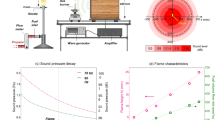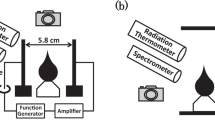Abstract
A SEVERE indisposition, which disabled me from correspondence during nearly the whole of last month, prevented me from acknowledging as soon as it appeared in NATURE (vol. x. p. 244) Prof. Barrett's excellent communication on Sounding and Sensitive Flames, replying to my letter on the same subject at page 233 of this volume. Prof. Barrett supplied me with many useful references, and with one at least the want of which led me to misrepresent his connection with the discovery of sensitive properties in suitably adjusted wire-gauze flames, for which I had sought in magazines and journals for some months previously in vain. A note of the original description of Mr. Barry's experiment in NATURE, vol. v. p. 30, had in the meantime been pointed out to me in another record of very similar experiments, which is itself also, I have no doubt, the same account of “further experiments with the same kind of flame,” that Prof. Barrett cites as appearing in the Journal of the Franklin Institute for April 1872, to which I have not been able to obtain access. The nearer channel to which I was referred for its perusal is the Philosophical Magazine for June 1872, where a paper is briefly extracted from the American Journal of Science of the preceding month, describing new experiments with Barry's sensitive flame, by Mr. W. E. Geyer, of the Stevens Institute of Technology, in the United States. By placing a wide tube over the flame at a proper height it became sounding, or, if silent, might be made sensitive in such a way as to sound at the slightest hiss or rustle, and on producing any jingling or tinkling sounds in its neighbourhood. Thus the flame sounded twice on pronouncing to it the word “sensitive,” showing its instantaneous affection even by momentary sibilant sounds. By varying the experiment, an opposite condition of the flame was obtained, in which it continued sounding until checked by a hiss or rustle from without. It is observed by the editor of the American Journal of Science, in a note to Mr. Geyer's paper, that in the number for September 1871, of the Moniteur Scientifique, a form of apparatus and experiment apparently identical with Mr. Barry's is noticed as having been made by Prof. Govi at Turin, and this was a few months prior to the letter in which the account of his experiments is given by Mr. Barry to Prof. Tyndall. Thus the sensitive properties of certain wire-gauze flames, like the property of such flames to excite very readily musical vibrations, may have had many independent discoverers; the value of such discoveries is now, as it must have ever been, the new light which one is capable of throwing upon another. The rapid publication of results urgently requires their frequent collection and comparison together; and this process, pressing and urgent as it is, seldom fails in experienced hands to prove a connection, to bind together a chain of consequences, and to leave a subject in general better explored and embellished with new-found illustrations than it was before. Such was the successful treatment, a few years ago, by Prof. Tyndall, of the question of sounding and sensitive flames, when it was shown by beautiful illustrations of Savart's sensitive water-jets, and by equally ingenious and new experiments with smoke-jets as substitutes for flames, that sensitiveness is a residing property of liquid veins and gas-jets, independently, in the latter case, of their being lighted. The laws of fluid pressure and motion, and apparently foremost of all those of capillary attraction in liquids and of mutual friction and diffusion in gases, and not the energies of heat and combustion of a flame, preside principally over the observed phenomena. The bifurcated head, or low ruffled brush to which the tall wand-like sensitive jet is suddenly reduced, is but the glowing representation of the form which, if it were visible to the eye, the unlighted jet would, under the same circumstances, be observed to take. This is at least in general terms, and perhaps also in plain and fairly accurate statement of the real facts, the simple result which the collection and elucidation of the most brilliant then known experiments illustrating sensitive flames, led a philosopher of Prof. Tyndall's enlightened sagacity and skill in physical investigations to adopt. There can be no doubt of its substantial correctness in the increasing array of cases to which it may be successfully applied. The flame is but an illuminuated effigy of some of the lowest parts of the issuing gas column, whether tranquil or disturbed, whose upper parts it removes and replaces by products of combustion. The lower parts are also marred in their form by heat, but not so much as to obliterate the original character, shape, and dimensions of the part of the gas column that it represents. The flame terminates upwards, and ceases to represent the unlighted column further when it has found surface of contact enough with the outer air to effect the complete combustion of the gas. The up-draught of violently heated products of combustion near the base impedes the access of fresh air to parts near the summit of the flame, and it must, besides, deform them otherwise, sometimes even rhythmically, as in the unsteady throbbing flame of an ill-trimmed lamp or of a candle burning in its socket. The noisy roar with which flaring of gas-flames is attended tells us also of the uneven mixture of the gas and air supplies with each other in the flame, and reminds us of the rapid fire of small explosions that must probably introduce new sources of confusion in its form. If these explosions, however, are regularly timed, they can be made to maintain the simple musical note of harmonic flames ; and these flames again, wholly dependent as they appear to be on their combustion for the musical sounds that they emit, must, it appears from Count Schaffgotch's and Prof. Tyndall's well-known experiments, when placed in certain circumstances of silence and indifference in an open tube, be aided by the voice at a distance to commence their song. The signal-note first raises certain mechanical vibrations in the gas-current of the narrow jet, that are necessary in the outset to produce commotions enough of the singing flame to make it able to continue and maintain them. The sensitive sounding-flame of Mr. Geyer bears a similar explanation, for not being regularly adjusted, although very nearly so, to continued sounding, a rustle sufficient to flurry the sensitive wire-gauze flame under the open tube creates in it so many brisk explosions, that the resonance of the sounding-tube is excited, and is at once exalted to a loud note by the rhythmical expansions of the flame ; but with the cessation of the external sound the maintaining impulse ceases, and the wire-gauze flame whose commotions must be kept up in order to maintain the note immediately becomes as silent as before.
This is a preview of subscription content, access via your institution
Access options
Subscribe to this journal
Receive 51 print issues and online access
$199.00 per year
only $3.90 per issue
Buy this article
- Purchase on Springer Link
- Instant access to full article PDF
Prices may be subject to local taxes which are calculated during checkout
Similar content being viewed by others
Rights and permissions
About this article
Cite this article
HERSCHEL, A. Sounding and Sensitive Flames. Nature 11, 6–8 (1874). https://doi.org/10.1038/011006b0
Issue Date:
DOI: https://doi.org/10.1038/011006b0
Comments
By submitting a comment you agree to abide by our Terms and Community Guidelines. If you find something abusive or that does not comply with our terms or guidelines please flag it as inappropriate.



